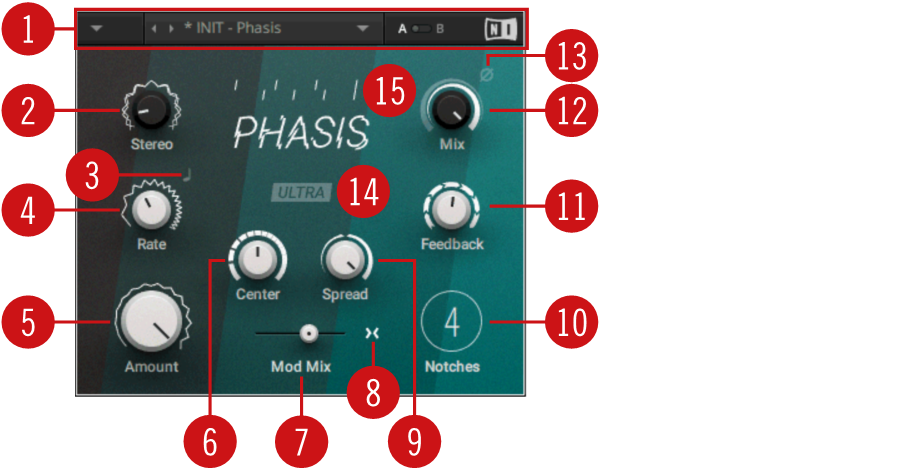PHASIS
PHASIS enriches sounds by adding spectral animation and complex filtering. This section includes a general note about phaser effects and an overview of the PHASIS plug-in.
In this chapter you can learn about PHASIS. It includes a general note about phaser effects and an overview of the PHASIS plug-in.
About Phaser Effects
Phasers are used to enrich sounds by adding spectral animation and complex filtering. They are based on a series of all-pass filters, with built-in modulation of the all-pass filter’s frequencies. The all-pass filters produce peaks and notches in the frequency spectrum that can be altered over time. This way a phaser transforms and animates the harmonic structure of the sound. The results range from classic Krautrock guitars to psychedelic FX sounds.
As one of the most commonly used guitar and studio effects, various implementations of the phaser have found their way into studio rack processors and guitar pedals. PHASIS is a new take on the concept with additional features that have been carefully chosen to allow for more sophisticated and extreme sounds than possible with common phasers, while staying true to the ease of use and clarity associated with these devices.
Overview of PHASIS
PHASIS features a scalable amount of all-pass filters, producing up to twelve pairs of peaks and notches in the frequency spectrum. The input signal’s stereo image is preserved, however additional processing can be applied to widen the sound (Stereo parameter). The internal modulation system can not only alter the relative center frequency of all peaks and notches at the same time (Center parameter), but also their spacing to each other (Spread parameter), allowing for vowel filtering effects. Further expanding on the original concept of a phaser, ULTRA mode extends the frequency ranges of the all-pass filters as well as the modulation to audio rates, further expanding on the filtering capabilities of PHASIS create sounds reminiscent of FM synthesis.

Header: Provides global functions related to preset management and plug-in behavior. For more information, refer to Header and Presets.
Stereo: Creates a wide and lively stereo effect by adding a phase offset to the modulation applied to the the left and right stereo channels. In center position, the phasing effect does not alter the stereo image. When turning the knob to the left, the phasing effect appears to move from right to left. When turning the knob to the right, the phasing effect appears to move from the left to right. Stereo does not have an effect if Amount is set to 0.
LFO Sync: Synchronizes the modulation to the host tempo and replaces the Rate knob with the LFO Sync controls.
Rate: Adjusts the frequency of the modulation. When LFO Sync is activated, modulation is synchronized to the host and the Rate control is replaced by the LFO Sync controls:

The Numerator (a) and Denominator (b) set the speed of modulation in musical notes relative to the host tempo. The Numerator sets the number of notes, while the Denominator sets the note value. The Sync Mode (c) sets the time value, or subdivision, for the chosen note value. For example, 1|4 in Sync Mode Straight means that the modulation repeats its cycle after one quarter note, and 3|2 in Sync Mode Triplet means that the modulation repeats its cycle after three half note triplets.
Amount: Adjusts the amount of modulation, adding movement to the effect. The modulation can be distributed between Center and Spread using the Mod Mix slider.
Center: Shifts the peaks and notches in the frequency spectrum by changing the frequencies of the all-pass filters that create the phasing effect (relative to the Center frequency).
Mod Mix: Distributes the modulation between Center and Spread. Moving the slider to the left increases the amount of modulation applied to Center, moving the slider to the right increases the amount of modulation applied to Spread. In middle position, the amounts of modulation applied to both Center and Spread are the same.
Mod Mix: Distributes the modulation between Center and Spread. Moving the slider to the left increases the amount of modulation applied to Center, moving the slider to the right increases the amount of modulation applied to Spread. In center position, the same amount of modulation is applied to both Center and Spread.
Spread Modulation Polarity: Inverts the polarity of the modulation applied to Spread, hence reversing its effect in relation to the modulation applied to Center.
Spread: Adjusts the density of the peaks and notches in the frequency spectrum. Turning the knob to the left moves the peaks and notches closer to each other. Turning the knob to the right moves the peaks and notches further apart from each other.
Notches: Sets the number of peaks and notches in the frequency spectrum.
Feedback: Adjusts the amount of feedback, or resonance, applied to the all-pass filters that create the phasing effect. Turning up Feedback makes the peaks and notches in the frequency spectrum more pronounced.
Mix: Blends between the dry signal and the wet signal by means of an equal-power crossfade.
Invert: Swaps the position of the peaks and notches in the frequency spectrum by inverting the effect signal.
Ultra: Extends the range of Rate and Center, allowing for more extreme modulation up audio frequencies. This can add new harmonic content to the input signal, similar to the sounds possible with FM synthesis.
Display: Shows the number of Notches, their position relative to the Center frequency, and their Spread in the frequency spectrum (from left to right), including the Amount and Rate of the modulation. If Stereo is used to add a phase offset to the modulation, this is indicated by a vertical split between the Notches.